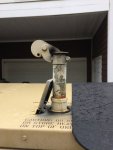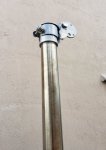mesias
Member
- 62
- 55
- 18
- Location
- South Florida
Hey guys,
I wanted to share a hood I had built for this unit and hear your feedback. The intent is to protect the unit mostly from heavy rain which is common in Fla. Most of the sound insulating foam lost the protecting coat and the rain would keep it endlessly wet. The hot air from rad is redirected to the back of the unit helped by an internal flap. The exhaust is also redirected to the side with some pipes. I tested the setup at full load (85%) for 45 minutes and no overheating issues. Below you can see a pic of the hood and HERE is a video of the test.

I wanted to share a hood I had built for this unit and hear your feedback. The intent is to protect the unit mostly from heavy rain which is common in Fla. Most of the sound insulating foam lost the protecting coat and the rain would keep it endlessly wet. The hot air from rad is redirected to the back of the unit helped by an internal flap. The exhaust is also redirected to the side with some pipes. I tested the setup at full load (85%) for 45 minutes and no overheating issues. Below you can see a pic of the hood and HERE is a video of the test.






